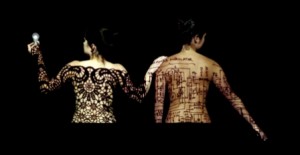Bare – Skin Safe Conductive Ink

Bibi Nelson, Isabel Lizardi, Matt Johnson, Becky Pilditch
http://www.bareconductive.com
“Bare” is the result of a graduate project at the Royal College of Art, created by Bibi Nelson, Matt Johnson, Isabel Lizardi and Becky Pilditch. This project began as an experimental investigation of parasitic technology, and developed into an exploration of the possibilities for bridging the gap between electronics and the body. “Bare” is an innovative and unique material that allows users to interface with electronic devices directly through gesture, movement and touch. The final formula was developed through a design-led material exploration. A thorough study of the history of body art and ornamentation led to the creation of an ink that humanizes wearable technologies and provides a sensuous method of applying electronics to the body through customized circuitry.
In its current form, “Bare” can be applied with a brush, stamp, or spray, and has been used to send information between people, people and computers, and to power small devices such as LEDs. The ink is currently best suited to low power, information-lean applications such as switching and simple data transfer. However, other potential application areas include dance, music, computer interfaces, communication and medical devices. The ink has the potential to sensually replace and augment existing technologies where wires are cumbersome or undesirable.
Temporary, non-toxic and water-soluble, this material is composed of non-metallic conductive particles suspended in food and cosmetic additives. This combination is the result of extensive research into a wide array of inert and non-toxic ingredients allowing for the safe application directly on the skin. The development process behind “Bare” generated over 120 different material samples before reaching the final formula. Connections between the ink and electronic devices are made through small electrodes placed directly on the skin that can transmit data either wirelessly or via cables.
“Bare” has been used to either power small devices directly, such as LEDs or to interface with the computer. The most poignant interface demonstration allows a dancer to use the surface of their skin as a musical instrument, simultaneously choreographing dance and composing music. In this performance, “Bare” is used as a conductive medium, bridging between electrodes placed on surfaces around a space (typically walls and floor). As different parts of the dancer’s body touch between these contacts, musical notes and patterns are created. The dynamic properties of the material allow for a wide variety of musical expression through manipulation of tone and rhythm. The result of this direct interaction between movement and sound is a unique and compelling performance.
